There were twenty-six members of the Children of Peace who participated in the Rebellion of 1837. They included Edward Brammer, John Brammer, Joseph Brammer, Charles Doan, Enos Doan, Jesse Doan, Judah Doan, Cornelius Dunham, Jeremiah Graham, John Graham, Richard Graham, William Graham, James Henderson, George Hill, William Hill, James Kavanagh, Jacob Lundy, Judah Lundy, Reuben Lundy, Alexander McLeod, John Reid, William Reid, Jr., William Reid, Sr., Peter Rowan, Hugh D. Willson, and John D. Willson.
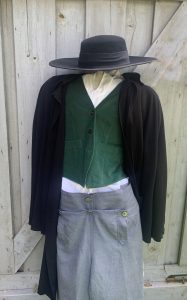
Replica outfit the rebels would have worn.
Not all rebels who marched went armed. Many marched down Yonge Street to show solidarity. They had no intention of participating in armed conflict. The rebels who were members of the Children of Peace are as follows:
Edward Brammer was born in 1811 in Rotherham, Yorkshire, England. He married Hannah Scales (1805-1882) with whom he had three children: Catherine Elizabeth, Edward (1843-1909), and Robert. He immigrated to Sharon in 1836 to join his older brothers. He participated in the Rebellion and got jailed for a brief period.
John Brammer, father to Edward and Joseph, was born in 1786 in Yorkshire, England. He married Ann Wright (1779-1864) with whom he had three sons. He was a prisoner along with John Montgomery in the Toronto jail. His name is on a Jesse Doan Rebellion box. He died in 1871 in East Gwillimbury.
Joseph Brammer was born on July 15th, 1809, in Yorkshire, England. He immigrated to Upper Canada as a young man. He lived with his family in the village of Hope in 1837. He married Ellen Lundy (1803-1886) with whom he had eight children. He participated in the 1837 Rebellion, speaking out against the Family Compact while maintaining his loyalty to Britain. He reported the harsh conditions that of the battle at Montgomery’s Tavern: “It was said his boots froze to his feet during the melee.” He got captured a few days after the battle. He was first held at the Old Kirk in Newmarket before relocation to a jail in Toronto. He never made it to trial as he escaped the prison to Buffalo a few days later during the release of other inmates.
Charles Doan was born in King Township in 1808. He was an active member of the Children of Peace, playing the bassoon in the band. He made a statement to authorities from his involvement in the Rebellion, giving vital information on how members of this peaceful sect came to be a part of the Rebellion. Charles crafted and sent a Rebellion Box to his father-in-law, David Willson, while he was in prison. A letter his wife Mary sent him while he was in prison is included in our exhibit.
Enos Doan was born around 1812 and lived in East Gwillimbury when he took part in the Rebellion of 1837. Information on his family life remains limited. He took part in the Rebellion alongside his brother Judah. Afterwards, persecution was a factor in his family’s move to the United States.
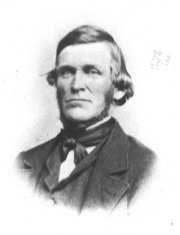
Jesse Doan, one of the imprisoned Children of the Peace members during the Rebellion.
Jesse Doan was born on September 15, 1814, in East Gwillimbury. Jesse participated in the 1837 Rebellion alongside his brother Charles. He built the Log Cabin that sits on the Temple site, and was the leader of the Children of Peace band. He was only 23 years of age when he was jailed for a few months in Toronto and created a Rebellion box.
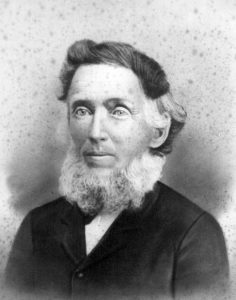
Judah Doan, an imprisoned rebel from the 1837 Rebellion and a member of the Children of the Peace.
Judah Doan was born in 1814. He took part in the Rebellion of 1837. He fought alongside his brother Enos and his cousins Charles and Jesse. Unlike Enos, he stayed in East Gwillimbury after the Rebellion. Records state his family left the Children of Peace after 1855. They left to become Wesleyan Methodists.
Jeremiah Graham was born in approximately 1801. He participated with his brothers William, John, and Richard in the Rebellion of 1837. Jeremiah and Richard fled to the United States to avoid detention after the combat. They returned later with their families. Jeremiah became a minister in the reformed Christian Church, also known as the Disciples of Christ.
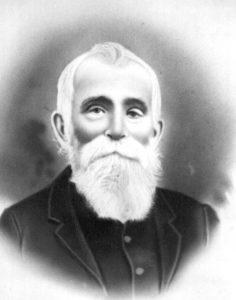
John Graham, an imprisoned rebel from the 1837 Rebellion and a member of the Children of Peace.
John Graham was brother to William, Jeremiah, and Richard. He participated alongside his brothers in the Rebellion of 1837. John made a Rebellion box for his sister Hester which is on display at the Sharon Temple. An article in The York Pioneer (the journal of the York Pioneer & Historical Society) from 1987 has letters written to John while he was in prison. They come from his brother William, sister-in-law Elizabeth and mother Hester. After the Rebellion, John left the Children of Peace. He is believed to have moved to the United States.
Richard Graham was brother to William, Jeremiah, and John. Although never a member of the Children of Peace, he participated in the Rebellion of 1837. He fought alongside his brothers. He also fled to the United States to avoid persecution.
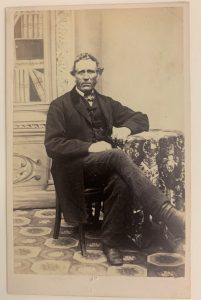
Portrait of William Graham seated.
William Graham was brother to Jeremiah, Richard, and John. He was born in New York state around 1806. He moved to Upper Canada with his family and became a member of the Children of Peace. He joined the Rebellion in 1837 and put in jail at the Old Kirk in Newmarket for his participation. He was released on bail and never tried. Unlike his brothers, William remained an involved member of the Children of Peace. His family left the sect in 1881, long after the death of David Willson.
James Henderson worked as a blacksmith in Sharon. He was shot and killed during the march on Yonge Street. He had married Ellen Hughes of the Children of Peace only a few months earlier, in March, 1837.
George Hill was originally from Bucks County, Pennsylvania. He served as a constable in East Gwillimbury as early as 1811. He married Lucy Hill with whom he had five children. Lucy died in 1830 at age 42, buried in the Sharon Burying Ground next to their oldest son Simpson who died in 1832 at age 22. By 1834 George owned a farm and tannery. There is little information about his participation in the Rebellion in 1837. He returned to Bucks County after the loss of his mill to a business competitor.
James Kavanagh was born in 1793 in St Mary’s Parish, Wexford, Ireland. In 1811 he enlisted in the 99th Regiment of the British Army. He was discharged in 1818 without paperwork. Retired military officers often became important figures in the colonial bureaucracy. Without paperwork James could not access these positions. His lack of pension and other benefits likely led to his participation in the Rebellion. Kavanagh was one of the two casualties in the battle. He was wounded “by a comrade” on December 5th and died in hospital on December 12th.
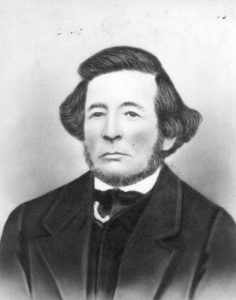
Jacob Lundy, an imprisoned rebel from the 1837 Rebellion and a member of the Children of Peace.
Jacob Lundy was born in 1809 to Israel Lundy and Rachel Hughes. He believed in the negative impact of the Family Compact and took part in the Rebellion of 1837. He was taken prisoner at Gallows Hill, and authorities wished to use him as a state witness. According to his obituary of June 21, 1878, he was unsure of the uprising against state authority. He lived to see his political hopes fulfilled with the establishment of Responsible Government. He was also a strong supporter of the Liberal Party.
Judah Lundy was born in East Gwillimbury in March,1813. His parents were Israel Lundy and Rachel Hughes. In 1837 he fought in the Rebellion before fleeing to the United States. He received amnesty and returned in 1839. He married Elizabeth Lepard in 1840 with whom he had five children. While a member of the Children of Peace, he played the flute in the Children of Peace band. In 1868, following David Willson’s death, he left the sect to join the Methodist Church. He died in October, 1897.
Reuben Lundy was Jacob and Judah Lundy’s brother. He was born in May, 1807, in East Gwillimbury. His parents were Israel Lundy and Rachel Hughes. He married Mary Ann Armstrong in 1835 with whom he had six children. He fought in the Rebellion of 1837 and was put in jail for five days. Knowledge of his involvement in the Rebellion remains limited. After the Rebellion he owned a hotel next to the Meeting House. This hotel burned down in 1859. After David Willson’s death, he left the Children of Peace in 1871. He became a member of the Christian Church (Disciples of Christ). He died in 1881 and is buried in the Sharon Burying Ground.
Alexander McLeod was born in 1808 to Murdoch McLeod and Rachel Terry. After the Rebellion he was sentenced to transportation. His transportation was to the British penal colony of Van Diemen’s Land (Tasmania). He died during the long sea voyage or shortly after he arrived.
William Reid, Jr. was born in 1806. He married Mary Hill with whom he had two children, Simpson Reid, and Emily Anna Reid. Knowledge of his involvement in the Rebellion is limited. William died in 1860 at age 54 and was buried in the Children of Peace Burying Ground. Mary lived to be 88, dying in 1900.
William Reid, Sr. was born in February, 1765, in Banffshire, Scotland. He married Mary Willson in 1794 in Upper Canada although it is unsure when they immigrated. Knowledge of his involvement in the Rebellion is limited. His son William Reid Jr. also took part in the Rebellion.
Peter Rowan was born in 1812 in Markham, Upper Canada. He married Deborah Rowan and had three children with her. Information about his involvement in the Rebellion is limited. In the 1871 Census for East Gwillimbury, he is listed as a blacksmith and a member of the Children of Peace. He died in 1875 at age 62 due to erysipelas, a bacterial infection in the upper layer of the skin.
Hugh D. Willson was the son of David Willson, leader of the Children of Peace, and Phoebe Titus. He was born on August 2, 1802, in East Gwillimbury. Like his brother John, he was an active member of the Children of Peace. He played the trombone and concert horn in the band. In 1837 Hugh participated in the march down Yonge Street. Afterwards he was sentenced to a jail term of six months. After the Rebellion he supported his father as an active member of the Children of Peace.
John D. Willson was born on August 28, 1807. He was the son of David Willson, the leader of the Children of Peace, and Phoebe Titus. He was an active member of the Children of Peace and played the violoncello in the band. John was an important figure in the Rebellion of 1837. He transported the weapons of the East Gwillimbury rebels in his wagon. Despite this, he never actually participated in the rebellion. He returned home with his father before the Yonge Street battle began. While he did not take part in the fighting, John was still jailed for six months in a Toronto prison. He shared a cell with Samuel Lount and Peter Matthews, both of whom were executed. John D. Willson would take over as leader of the Children of Peace following his father’s death in 1866.
Rebels with limited information available:







